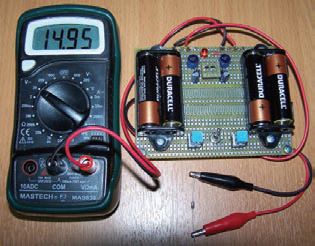To measure a zener diode’s breakdown voltage, you need a dc voltage source whose voltage exceeds that of the zener voltage. In Figure 1, resistor RSER provides voltage drop between VINand VZEN. In any case, VIN should exceed VZEN. Resistor RSER must provide current, IZEN, that can keep the zener diode in reverse breakdown. That is, the current must be more than IZEN-IZENMINand less than IZEN-IZENMAX. You also need to consider the current that flows through the load. Otherwise, VZEN will be unregulated and less than the nominal breakdown voltage. Also, the power that the zener diode dissipates should not exceed the manufacturer’s specifications. Except for the value of IZEN-IZENMIN, all necessary data appears in zener-diode data sheets.
The circuit in Figure 2 uses one or two AA/AAA cells, which ensures testing irrespective of the value of the tested zener voltage to approximately 20 to 25V. The heart of the circuit is a ZetexLED driver, ZXLD381. It operates mainly from 1.5 or 1.2V cells, and it has a maximum input voltage of 10V. The LED driver generates constant-power pulses that charge output of the 10-μF capacitor, which requires low leakage current. The capacitor’s voltage provides constant current through R1 and tthe zener diode that connects in series. When you connect output probes to a digital multimeter’s V and COM sockets, you can directly measure the zener’s voltage when the S2 switch is in the position Figure 2 shows.
When S2 is in the upper position, the meter measures voltage across R1, a 1-kΩ resistor; the meter displays a negative-voltage-drop value. R1‘s value ensures direct reading of the meter; the voltage drop across R1 corresponds to the zener’s current, so there is no need to switch over DVM (digital-voltmeter) ranges. R1‘s voltage drop limits the zener diode’s voltage value that the circuit measures. If R1‘s value is 1Ω, then the voltage drop across it is insignificant and, in millivolts, is equal to the zener diode’s current in milliamps.
For more detail: Circuit lets you measure zener voltages and test LEDs

